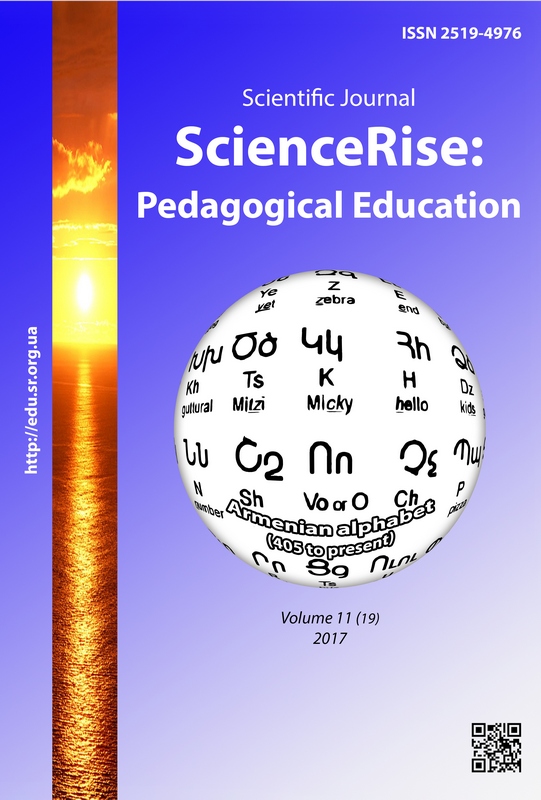Formation of communicative competence of students of technical higher education in the process of foreign language teaching
DOI:
https://doi.org/10.15587/2519-4984.2017.116027Keywords:
foreign language study, communicative competence, professional formation, professional orientation, foreign language communication, person-oriented approachAbstract
A graduate of the higher technical school, who has received a high level of communicative competence and the ability of a foreign language fluent speaking, uses it in his professional life actively, has the best opportunities for a job and a lot of advantage to communicate with foreign partners.
Success in mastering a foreign language teaching in higher technical educational etablishments depends not only on personal characteristics, characteristics of a higher nervous activity and the students’ nature, but also it depends on their level of motivation and the development of special - foreign abilities. Accordingly, some students learn language better, the rest – a language system. The productive nature is more comprehensible for the first group of students, i.e. the active mastering of a foreign language, and the second group is more successful in passive mastering of a language (listening and reading, perception and understanding of another's speech). On the one hand, it indicates the existence of intuitive - perceptual and rational - boolean types of mastering a foreign language, and on the other hand- the communicative and non-communicative (linguistic). Physiological basis of this distinction is the lability of nervous processes (in the first case), and inertia of the nervous system( in the second case). The difference between these two types is particularly evident when using intensive methods of teaching a foreign language.
It was demonstrated that it is necessary for teachers to know a foreign language as a system (vocabulary and grammar) and not be able to communicate in a foreign language, teachers should consider when teaching students with support for the principles of individual personality-oriented approaches to learning a foreign language in technical institutions
References
- Vygotskiy, L. S.; Davydov, V. V. (Ed.) (1991). Pedagogicheskaya psikhologiya. Moscow: Pedagogika, 480.
- Kondrashova, L. V. (2007). Protsess obucheniya v vysshey shkole. Krivoy Rog: KGPU, 318.
- Metodika prepodavaniya inostrannykh yazykov v vuze. Inostrannyye yazyki na nespetsialnykh fakultetakh (1978). Leningrad, 1, 197.
- Tkach, M. V. (2005). Do pitannya pro kreditno-modulnu sistemu v navchannі: іnozemnі movi. Nauka і osvіta, 7-8, 76–78.
- Izarenkov, D. I. (1990). Bazisnyye sostavlyayushchiye kommunikativnoy kompetentsii i ikh formirovaniye na prodvinutom etape obucheniya studentov-nefilologov. Russkiy yazyk za rubezhom, 4, 54–60.
- Kabardov, M. K. (1996). Tipy yazykovykh i kommunikativnykh sposobnostey i kompetentsiy. Voprosy psikhologii, 1, 34–50.
- Tovazhnianskyi, L., Romanovskyi, O., Ponomarov, O. (2002). Osobystisno oriientovane proektuvannia systemy pidhotovky natsionalnoi humanitarno-tekhnichnoi elity. Pedahohika i psykholohiia profesiinoi osvity, 3, 40–46.
- Gez, N. I. (1985). Formirovaniye kommunikativnoy kompetentsii kak obyekt zarubezhnykh metodicheskikh issledovaniy. Inostrannyye yazyki v shkole, 2, 17–24.
- Kasianova, V. G. (1995). Psikhologicheskiye osnovy formirovaniya professionalnykh inoyazychnykh umeniy u studentov ekonomicheskikh spetsialnostey vuzov. Moscow, 24.
- Oleksenko, V. (2004). Efektyvni shliakhy vdoskonalennia zmistu i form pidhotovky spetsialista VNZ. Vyshcha osvita Ukrainy, 2, 66–70.
Downloads
Published
How to Cite
Issue
Section
License
Copyright (c) 2017 Tetiana Kartel, Hanna Syvokin

This work is licensed under a Creative Commons Attribution 4.0 International License.
Our journal abides by the Creative Commons CC BY copyright rights and permissions for open access journals.
Authors, who are published in this journal, agree to the following conditions:
1. The authors reserve the right to authorship of the work and pass the first publication right of this work to the journal under the terms of a Creative Commons CC BY, which allows others to freely distribute the published research with the obligatory reference to the authors of the original work and the first publication of the work in this journal.
2. The authors have the right to conclude separate supplement agreements that relate to non-exclusive work distribution in the form in which it has been published by the journal (for example, to upload the work to the online storage of the journal or publish it as part of a monograph), provided that the reference to the first publication of the work in this journal is included.








